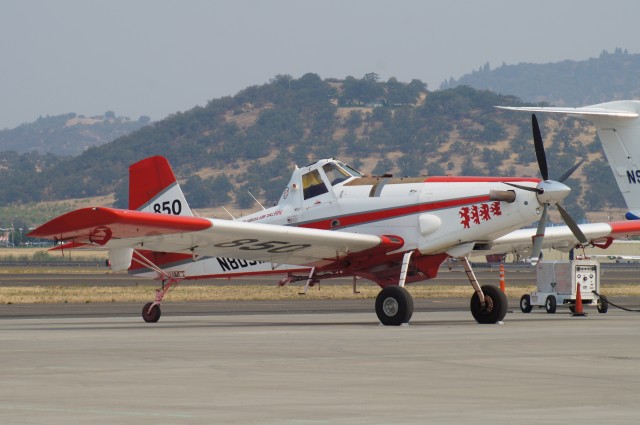
An AT-802F Air Tractor (check out the “fire words” on the nose) – Photo: Julian Cordle
Last November, I brought you an initial introduction into the world of Aerial Firefighting. That article focused on the concept, tactics and state of aerial firefighting. I promised a second look at the aircraft of Aerial Firefighting, so here we go!
First, let’s review the types of fixed-wing aerial firefighting aircraft and the associated designations and acronyms.
SEATs (Single Engine Air Tankers) are short-range, small, one-person aircraft with less than approximately 1,000 gallons of usable retardant capacity. The most well-known example here is an AT-802F Air Tractor and the ’œFire Boss’, which is a model AT-802F fitted with floats.
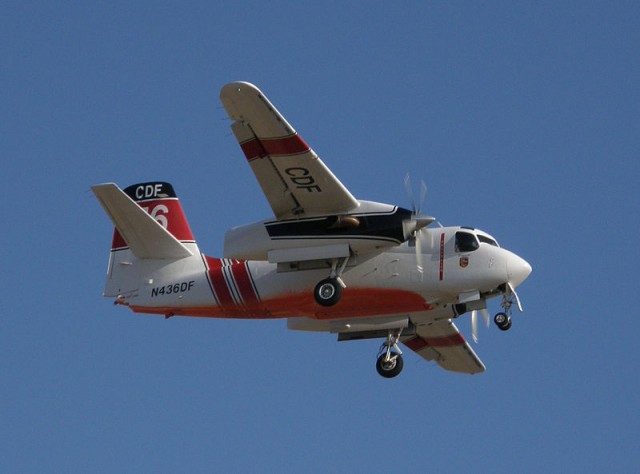
A Grumman S-2T converted to fire fighting duty – Photo: Alan Radecki | WikiCommons
Next we have the Large Air Tankers (LATs): of Type III, II, and I. Type III air tankers can dispense approximately 1,200 gallons per drop. The best example in this class could be the Grumman S-2T, which are re-engined Grumman S-2 ’œTracker’ Navy patrol aircraft. CalFire currently has 20+ of these in service.
Type II tankers include such interesting aircraft as the purpose-built Canadair CL-215 ’œSuperScooper’, with high, oversized wings and v-hull for scooping up up to 1,250 gallons of water to deliver to a fire.
Moving up the line, we see typical Type I LATs coming to the table with between 1,600 and 2,750 gallon capacities. In this class we see some interesting examples, like the beautiful piston-driven birds of Douglas: the DC-6 and DC-7, the popular Lockheed P3-Orion, and the gorgeous scooper Martin Mars, which is worthy of an article all its own.
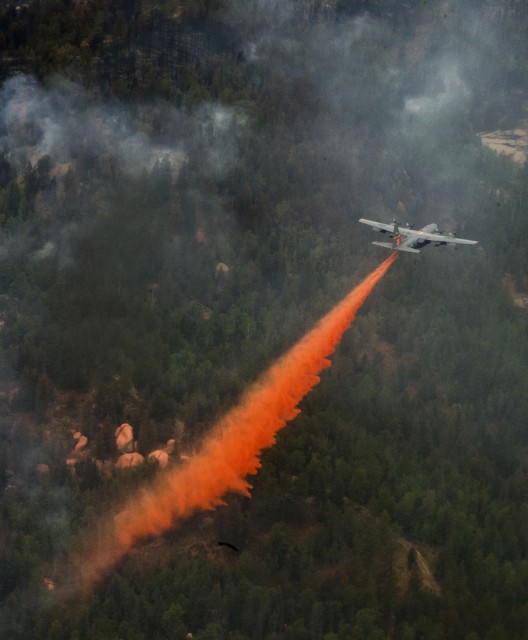
MAFFS-equipped C-130 Hercules – Photo: Staff Sgt. Stephany D. Richards | USAF
We also see the occasional MAFFS (Modular Airborne Firefighting System), which are temporary conversions of National Guard C-130 Hercules aircraft into aerial firefighting roles. Lastly, we see the big birds: the VLATs: Very Large Air Tankers. These represent tankers with massive capacities of 10,000+ gallons, including a converted 747 with a 20,000+ gallon capacity!
Readers may notice that Neptune Aviation played a significant role in the previous article, and there’s a good reason: the Montana-based company has had a significant presence here in Medford, Oregon (where I live) during this season, and was fantastic to work with them both on-site at MFR, and through conversations with Dan Snyder, the COO, back in the Missoula head office.
Of particular interest is Neptune’s use of the Lockheed P2V -5 and -7 aircraft (Type II Air Tankers), which were originally designed in the late 1940’s as a US Navy maritime patrol aircraft. Naturally, with older aircraft comes legitimate concerns of safety and reliability (you’ll remember from our last article the reference to the summer of 2002, where two high-profile structural failures of older air tankers caused the deaths of five pilots within four weeks).
Neptune COO Dan Snyder tells me that Neptune has stepped up its commitments to safety, having invested heavily in their aircraft by developing a industry-leading program for maintenance, inspection, and fatigue analysis for airframes and parts. The proof is in the pudding: the pilots I met spoke with confidence about flying these aircraft in their chosen missions.
The aircraft itself is an interesting beast. Primarily powered by a pair of Curtiss-Wright R-3350-32W reciprocating piston engines (generating about 2,900 HP each), it also (in the -5 versions and later) came with supplemental J34 turbojet engines. In the case of the Neptune aircraft, these are used only during high-thrust scenarios of takeoff and low-level runs for retardant drops. The result is a peculiar mix of thumping piston and screaming jet sounds from the same aircraft.
As for specific firefighting modifications, these aircraft are probably simpler than most might imagine. Neptune removes the primary bomb bay assembly and replaces it with a 2,000 gallon retardant tank and dump mechanisms which they custom build themselves. The entire system is inspected, tested, and certified for aviation use by federal air tanker officials. Other than those modifications, the plane looks and feels much like its 1950s heritage and could easy serve as a stand-in on any Cold War aviation museum set.
At one point while studying and touring the aircraft, I set my notebook and camera down to consider the graceful strength of this old bird, and it left me contemplating the sixty years of faithful service since her birth. After appreciating the rugged electronics section of the flight deck, with its blocky, bold 50s-era typeface gracing every panel and warning label, I took a step down the ladder to the ground.
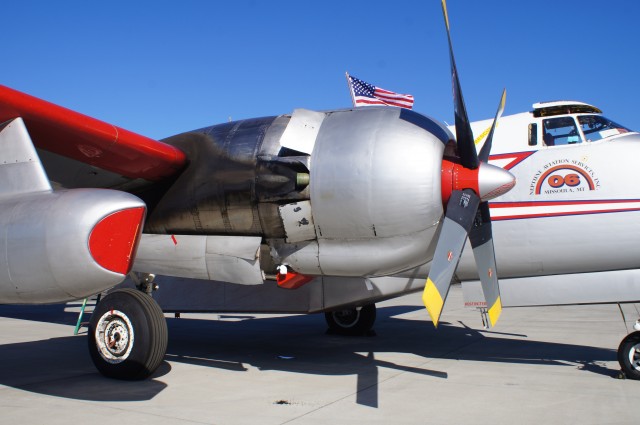
The soot from the engine is a sign that this is a classic bird – Photo: Julian Cordle
The engine cowling was clean and freshly painted, save for a bright, unpainted panel next to the exhaust. Here, the engines fiery breath menaced the polished metal with a permanent black, sooty tail that streaked down the engine pod and leapt across both upper and lower sections of the wing junction. Neptune knows better than to try and paint that panel. That blackened, heat-seared panel has likely looked that way for sixty years, and the smile on my face reminds me that that is exactly how it should be. What a truly remarkable aircraft.
From there, I had the chance to check out Neptune’s ’œNext Generation’ air tanker. These air tankers are derived from the British Aerospace 146-200 (BAe-146) regional airliner, and Neptune has a total of six currently in service.
Each one carries a 3,080 gallon internal tank, which is housed in the middle of what would’ve been the main passenger cabin. In this case, Neptune tanker #10 uses the newest version of their BAe-146 tank system, dubbed ’œRev 300’. Contrary to popular belief, the tank is not pressurized, but instead it vents right into the cabin area (hence the ’˜mud’ splatter on the ceiling above the tank vent).
When a drop is started, the tank pulls in air from the cabin through the giant opening on top, which draws in outside air from a special ’œflapper’ that has replaced a normal passenger window panel. The result, I’m told, is a near-unstoppable force of 27,000 lbs of ’œmud’ pouring out the custom-designed nozzles beneath the fuselage. This design both simplifies the overall system and makes for a safer aircraft, since the tank can only either be full of retardant (and vented open on top) or empty, but with the same atmospheric pressure as the rest of the aircraft.
Up in the cockpit, it feels very much like a modern four-engine airliner, with big gauges, comfortable seats, and a wide, spacious view outside the windows. There’s a few subtle details, however, that hint at this aircraft’s unique purpose. It’s hard to miss the pair of Apple iPads mounted on either side of the cockpit, but perhaps most telling is a light grey panel in the center console with an attention-grabbing red button labeled ’œDROP’.
This particular panel is littered with much newer dials, controls and switches than other panels, with labels such as ’œDROP VOLUME’ and ’œCOVERAGE’. After a brief explanation from Neptune pilot Chris Holm, it’s clear that this is the brains of the mission, and the controls and capabilities Chris describes are pretty impressive, like the ability to automatically meter and hold a set drop volume regardless of pitch angle, speed, altitude, or turn radius.
Chris goes on to tell me that the BAe-146 is a strong, maneuverable aircraft to fly, and the position of the tank right over the center of gravity means that there is no major change in the flight characteristics before, during, and after a load drop. The excellent flight capabilities cannot be understated, he says, since the aircraft spends an abnormally-high amount of time at dicey, low-level flight with little room for error.
One interesting note about this aircraft is the complete lack of thrust reversers on the Honeywell ALF 502 engines. Instead, the BAe-146 does pretty well with both lift dump spoilers and a very unique set of split-tail side spoilers, which you can see in operation just after the 2-minute mark in this fantastic video.
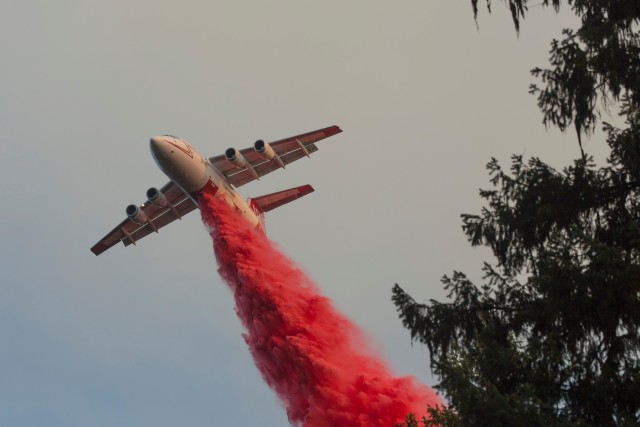
One of Neptune’s Bae-146s dropping mud on a fire – Photo: U.S. Forest Service
Because of all of this, Neptune COO Dan Snyder says that the BAe-146 is a simple, predictable, reliable, and all-around very capable aircraft which is well-suited for aerial firefighting. Currently, Neptune is building its seventh BAe-146 air tanker, having just acquired the aircraft from a major European regional airline. They expect “The 146” to carry them well into the future.
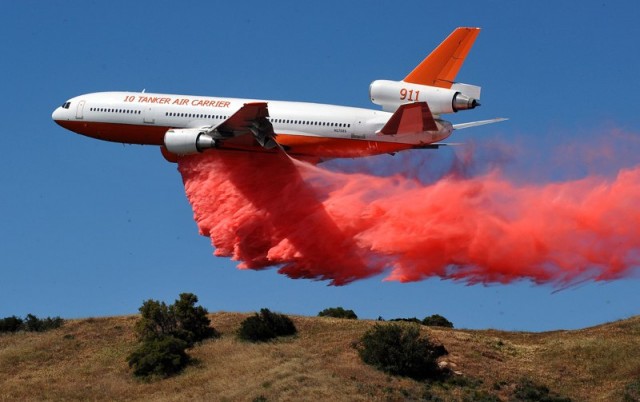
10 Tanker Air Carrier releases their load – Photo: 10 Tanker
To wrap up this story, we take a look at the ’œbig daddies’ of aerial firefighting: the converted DC-10 aircraft operated by 10 Tanker Air Carrier. Of the three DC-10 tankers in service worldwide, I was extremely lucky to catch two (#911 and #912) in Medford together at the same time, which is an exceptionally rare sight! Unfortunately, unlike the previous tankers which I was able to catch up-close during “standby” time between missions, the DC-10’s were in heavy rotation, so I was limited to shooting photos from afar.
During this day, it wasn’t uncommon to see a giant DC-10 land, taxi over to the air tanker base, take 20 minutes to load with retardant with engines running, buzz out to the runway and leap into the air, only to return again in 30-40 minutes. Add the second DC-10 tanker doing the same thing at the same time, and you can begin to imagine the circus of logistics happening to keep this operation going.
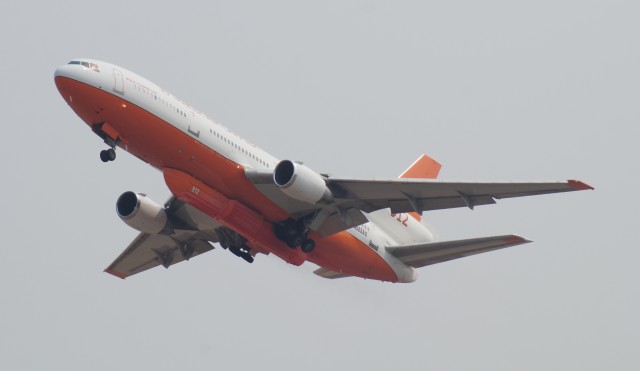
Able to see some of the modifications to the 10 Tanker – Photo: Julian Cordle
These aircraft are true VLATs, carrying about 12,000 gallons per load in unique externally-mounted, vented tanks. These bad boys can lay down retardant 50-feet wide and nearly 4,000-feet long, or they can split the load into smaller individual drops. It’s important to note that while these are indeed very impressive capabilities, the Incident Commanders (IC) need a wide variety of tools to fight fires, and “biggest isn’t always the best.” When picking tools to addressing fires, fighting every fire with a sledgehammer is wasteful and expensive when a smaller, closer option might be available.
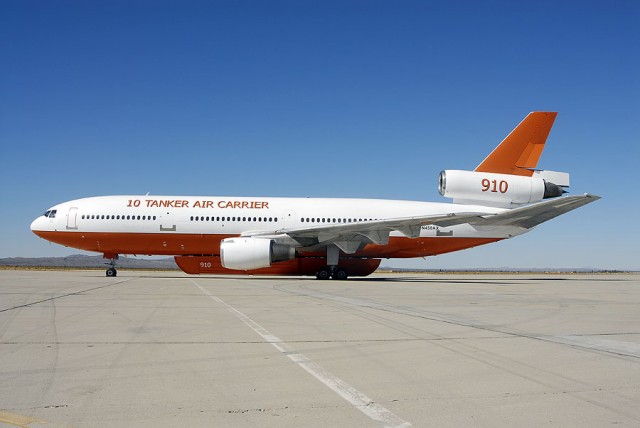
DC-10 tanker on the ground – Photo: 10 Tanker
ICs often have to utilize and shift available aerial firefighting resources based on frequently-changing variables to determine the right tool for the job; things like the type of fire (forest vs. grass), location (flatland vs. mountainous terrain), weather, and the possibility of localized water sources (where scoopers and rotary-wing aircraft can really shine).
Then there’s the very nature of the fire: is it a long-standing war on a major regional fire (like the two-and-a-half-month Happy Camp fire of 2014, which caused nearly $90 million in damages), or is the priority sniffing out and quenching new “hotspots” started by lightning strikes from quick-moving thunderstorms?
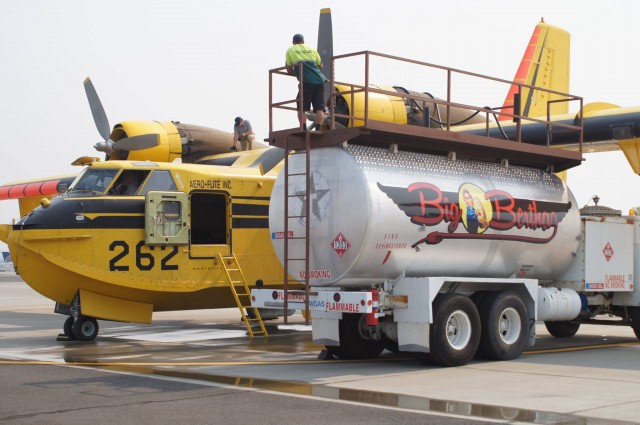
CL-215 scooper gets a refuel from “Big Bertha” – Photo: Julian Cordle
Lastly, we take a look at the impressive numbers associated to one particular busy day of firefighting: September 7th, 2014. That was the day I decided to visit the Medford airport to take pictures of the air tankers with my son, but it wasn’t until later I learned that it was one of the heaviest days of aerial firefighting on record for the Medford Air Tanker Base.
Thanks to my friends at Million Air Medford, we were up close to see it all ’“ multiple VLAT’s, scoopers, various Type I, II, and III air tankers, and even a few heli-tankers. The base loaded (and reloaded) the same two DC-10 VLAT’s eight individual times, totaling over 84,000 gallons (or about of three-quarters-of-a-million pounds) of mud dropped on fires in the region in one day.
Finally, across the 2014 firefighting season as a whole, the Medford Air Tanker Base pumped over one million gallons of retardant (about ten million pounds) into 31 different aircraft, which made for a total of 562 landings here at MFR while fighting fires all over the west. All of this was happening while MFR was serving as an active, busy regional airport with 20-30 commercial flights per day.
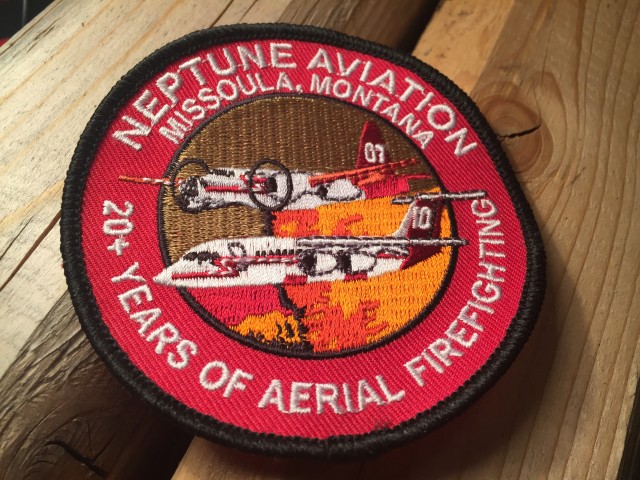
Patch from Neptune Aviation – Photo: Julian Cordle
These numbers are a solemn reminder of how hard these aerial firefighting teams work to protect our forests, and in some situations, our homes. While I appreciate the opportunity to share all about this fascinating side of aviation, I hope you’ll only ever have to experience aerial firefighting in videos, pictures, and articles like this. If for some reason you do see them up close, I hope you’ll appreciate these amazing machines, but most importantly: the men and women in the air and on the ground who risk their lives fighting these fires. I cannot thank them enough.
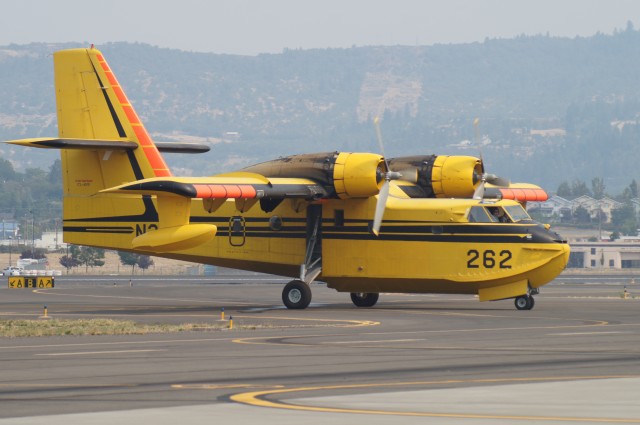
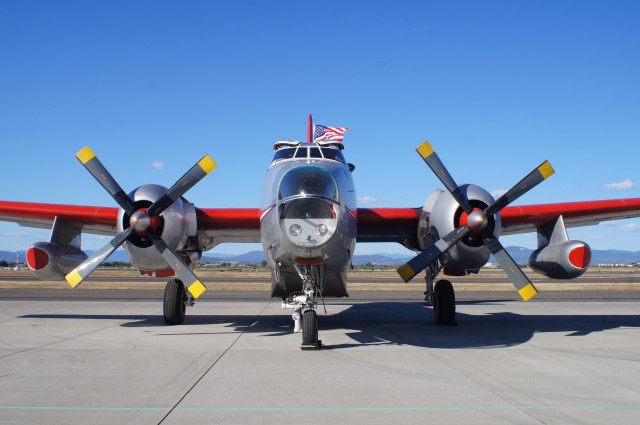
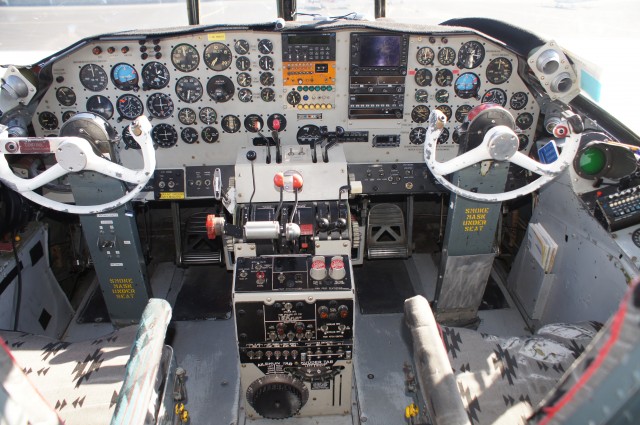
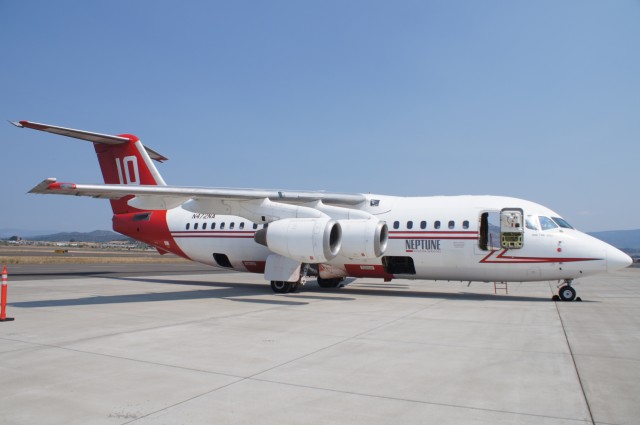
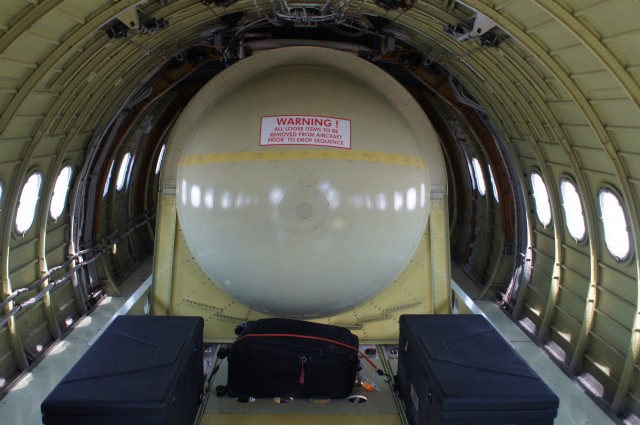
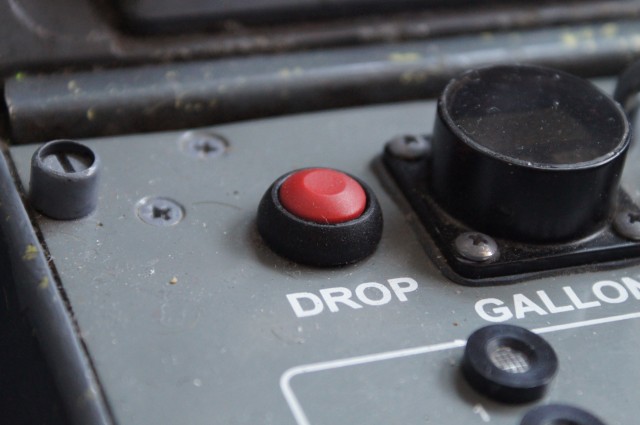
Julian – Your most informative, well written article is really appreciated, and the excellent photography is “icing on the cake!” A great way to start out an AvGeek’s day – Sincere thanks for sharing…
Julian- What a great, informative piece. An excellent take on a hand full of airlines that I will venture to say few are aware of. Thanks for sharing. And like Mike said, excellent photos!
JL Johnson | AirlineReporter
Mike/JL – Thanks for the kind words. I’ve genuinely enjoyed the research on the topic. Very cool planes, and very cool people. Thanks again!
In either of your articles did you have any pictures of Chris Holm? Loved your articles
Hi Pat –
No, I didn’t. Chris explicitly asked to not be photographed. 🙂
Julian
True story about the initial 10 Tanker drop tests…when the company wanted to see how the retardant would disperse, a field full of cups was set up, then the original Tanker 910 (N450AX) made its first pass. Bam! Pattern revealed!
Mike H.
FlightJournal.com
Awesome – I wasn’t aware of that. Thanks for sharing, Mike!
At AA, When we had the BAE 146, we were told that BAE stood for bring another engine! The engines at that time were not very reliable.
Dear Sir,
We seek to quote Firefighters Aircraf FOR RENT to attend Chilean fire, we have contracts ready, do send us quote and numbers of planes availables .
Stand by
Eduardo Th.Frugone
DEFCON S.P.A
Chile